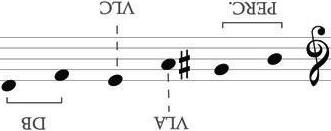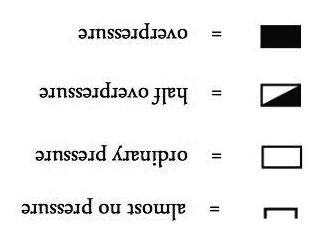IANNOTTA
They left us grief-trees wailing at the wall.
for 9 Amplified Instruments
Score


They left us grief-trees wailing at the wall.
for 9 Amplified Instruments
Score

They left us grief-trees wailing at the wall.
(2020) for 9 Amplified Instruments
Commissioned by Ars Nova, Riot Ensemble, and Wien Modern
World première: 13 November 2020, Wien Modern, Vienna (Austria), Riot Ensemble.
Instrumentation
Clarinet in B♭ (also bass)
Objects: 2 wine glasses (the pitch is not important, as long as it makes a sound as soon as you pass the finger on its edge), small mouth harmonica, aluminum sheet with contact microphone attached, cello bow, cardboard box.
Tenor Sax
Objects: 2 wine glasses (the pitch is not important, as long as it makes a sound as soon as you pass the finger on its edge), small mouth harmonica, aluminum sheet with contact microphone attached, cello bow, cardboard box.
Percussion
vibraphone (with motor)
crotales (2 for percussion, 1 for viola, 1 for cello, 2 for double bass):

waterphone
tam tam
polystyrene
guiro
bass drum

3 rins on timpano (rins: )

large, very low gong (pitch is not important, you can take the lowest you have)
ratchet
large thunder sheet (Inox-Stahl 2m x 1m, 0,7mm)
cymbal 18”
snare drum (to be given to the pianist for the wireless speaker)
2 cello bows
Piano (see preparation)
Objects: 4 Ebows, 3 vibrators + some fabric to reduce their vibration on the low strings, fishing line, viola or cello bow, large and heavy glass bowl, fork, 2 superballs, small mouth harmonica, aluminum sheet with contact microphone attached, cardboard box, snare drum with on top a wireless speaker (or transducer) connected to your phone (check instructions on the part).
E-Guitar (strings 5-6 detuned one octave lower)
Objects: 2 circular paperclips, viola or cello bow, bottle–neck, Ebow.
Pedals: reverb (Earthquaker Devices, Afterneath), freeze (Electro Harmonix Freeze Sound Retainer), distortion (Chase Bliss, Brothers), tremolo (Chase Bliss, Gravitas), glitch/swell (Infinite Jets), volume pedal.
Violin

rubber (ordinary) mute, metal mute, wooden mute
Preparation: piece of patafix at MSP on strings II and III
Objects: cardboard box, piece of polystyrene attached to the music stand
Viola

wooden mute, metal mute
Preparation: 1 circular paperclip at AST on string II, piece of patafix at MSP on string III
Objects: cardboard box, piece of polystyrene attached to the music stand, crotale C♯5 (see percussion list)

Cello 8
rubber (ordinary) mute, wooden mute
Preparation: 1 circular paperclip AST on string III, piece of patafix at MSP on string II
Objects: piece of polystyrene attached to the music stand, crotale F5 (see percussion list)
Double Bass (5 strings)
rubber (ordinary) mute

Preparation: piece of patafix at MSP on strings I and III
Objects: piece of polystyrene attached to the music stand, crotales E5, G5 (see percussion list)
NB: all string instruments should have NO metal parts between the fine tuners and the tail piece.
For all musicians: please check all the videos provided by composer.
Performance Notes
- Accidentals apply only to those notes before which they are placed, with the exception of repeated notes.
- Phrases should aways be played legatissimo, unless marked otherwise.
Winds:
Preparation of the bass clarinet and sax: cover the bell of the instrument with a stiff sheet of paper — a laminated A4 sheet is suitable — fixed with a bulldog clip. The sonic result is low buzzing sound.
You can see a photo and some samples of the preparation on Heather Roche’s blog: https://heatherroche.net/2014/03/24/on-bass-clarinet-preparations/
Multiphonics:
all the clarinet’s multiphonics are taken from Heather Roche’s blog — www.heatherroche.net all sax’s multiphonics are taken from Markus Weiss/Giorgio Netti’s book — The Techniques of Saxophone Playing, published by Bärenreiter.
Piano:
Preparation:
Tape: place tape (or patafix) on the strings of the last fifth in the highest register of the piano to dump completely the resonance. Fork: place a for between the 3 strings of one very high note. If touched, it should make a ricochet sound. If you don’t want to put a fork, you can use a magnet (Neodymium Cylinder: 60mm height, 12mm diameter) instead.
Rubber: place a big rubber between the lowest two strings to cut the resonance. It has to sound almost like a bass drum.
Fishing line: should be placed on 3 consecutive pitches in the medium register. The 3 pitches should be slightly dumped using some patafix on an overtone node. Put rosin on it!
Patafix (measure 105): prepare the notes G3, A3 with patafix in order to get the first harmonic.
Strings:
Paperclip preparation: Preparation with patafix:


Left hand pressure:

= ordinary pressure
= half pressure
= lightly touching, as you would when playing harmonics
Right hand pressure (bow):

Bow positions and techniques:
molto AST = as close as possible to the left hand
AST = alto sul tasto
T = al tasto
PO = posizione ordinaria
SP = sul ponticello
MSP = molto sul ponticello
c.l.t. = col legno tratto
1/2 legno = half legno, half hair
Amplification:
Each instrument should be amplified, and a nice reverb should be applied.
www.claraiannotta.com
clara.iannotta@gmail.com
Duration: ~15 minutes
in C
Motor (ON) [very slow vibrato]
Before the beginning of the piece, place the 3 e-bows on the strings. The should be ready to make a sound as soon as you put down the III Pedal.
Before the beginning of the piece, place a piece of fabric (a bit thicker than a T-shirt) on the lowest strings of the piano, after the hammers, and put on top of it 3 vibrators (ON, lowest speed). When using the resonance pedal will be used, it should sound like a low, colored hum. If necessary, damp the strings with a cloth or heavy weight to prevent any sound until B.
(ON) 3 Vibrators (ON) on fabric
Preparation: II, III: patafix MSP (see performance notes)
Tuning:

Tuning: Preparation:
one circular paperclip AST (see performance notes) III: patafix MSP (see performance notes)

Preparation:
II: patafix MSP (see performance notes) III: one circular paperclip AST (see performance notes)
Preparation:
for 9 amplified instruments to Aaron Holloway-Nahum
They left us grief-trees wailing at the wall.
[with 2 bows] [slowly alternate between all 4 notes (1-2 at a time), trying to sustain all of them as much as possible]
Without playing, press the keys correspondent to the strings where you placed the 3 e-bows and fishing line. The e-bows should start to sound as soon as you press the III Pedal. Once the piece starts, block the III Pedal with a heavy weight or placing a pen behind it, so that it satys pressed without using your foot.
[almost no bow pressure] [alternating artificial harmonic of major 2nd with
I, III: patafix MSP (see performance notes) Wooden Mute Mute [almost no bow pressure] molto AST molto AST = bow extremely close to the left hand (you should be able to play the 3 strings at the same time.

Tuning: Tuning:

[almost no bow pressure]
l.v. until end of resonance
We should hear no attack. Try to create as many beatings as possible (between your 3 strings and also the e-bow inside the piano. Reverb ON, Irregular tremolo ON]
They left us grief-trees wailing at the wall.
[play the highest clear harmonics on strings 1-2 that you can get. Leave them resonate.]
[multiphonics on strings 3–2–1 (as a 3 or 2 notes chord) in the whole range (but mostly medium/high register). Touch the strings always when the volume is zero, and only then start to fade–in (the attack should never be heard). The sound should be very warm, airy, very reverbed, and with an internal rhythm (like an irregular tremolo) — watch video provided by composer]
[downbow: intense stuttering — NB: you can control the speed! upbow: squicky, still sound — watch video provided by composer]
between a warm, tailpiece-like sound, and a more distorted, metallic one (when closer to the strings)]
[Freeze the higher multiphonic you can get. Very metallic sound.]
[let the laminated paper vibrate on the cl.'s bell]
NB: the fade-out should be really "al niente".
(q = 60)
[let the laminated paper vibrate on the cl.'s bell]
FORK (between the strings in the high register) [hit the fork handle to make it vibrate (ricochet sound)]
the strings, if necessary.
BASS DRUM [with triangle beater] [with superball]
[scrape the Tam Tam very fast. The sound should be distorted and metallic.]
[extremely distorted, but warm, as deep and low as possible. Always multiphonics (the actual pitch is not important) on strings 4-5-6 — watch video provided by composer] h ) h ) ( h )
[cluster last 5th in the high register (prepared with tape)]
[like a bass drum]
[with bow]
[slow bow]
:[with bow] [slow bow] [let the sound desappear naturally, without forcing the decrescendo. Take the time it needs, going longer/shorter than the indicated duration] p [try to make the overtones appear as much as possible]
[play between the fine tuners and the strings attachment (watch the video provided by the composer). You should be able to oscillate between a warm, tailpiece-like sound, and a more distorted, metallic one (when closer to the strings)] [gently remove the e-bows from the strings] P / F P / F
[let the sound desappear naturally, without forcing the decrescendo. Take the time it needs, going longer/shorter than the indicated duration]
h ) ( h )
[play between the fine tuners and the strings attachment (watch the video provided by the composer). You should be able to oscillate between a warm, tailpiece-like sound, and a more distorted, metallic one (when closer to the strings)]
( h ( h
bow ad libitum (watch video)] q
[move slightly away from the tailpiece, bowing on the strings (which one is not important, as long as the passage is smooth). Slightly damp the strings (half pressure) with your fingers and bow very close to them. Change the pressure of the bow ad libitum (watch video)]
[move slightly away from the tailpiece, bowing on the strings (which one is not important, as long as the passage is smooth). Slightly damp the strings (half pressure) with your fingers and bow very close to them. Change the pressure of the bow ad libitum (watch video)]
[move slightly away from the tailpiece, bowing on the strings (which one is not important, as long as the passage is smooth). Slightly damp the strings (half pressure) with your fingers and bow very close to them. Change the pressure of the bow ad libitum (watch video)] ï ( h h ) h )
ï ()
[(beyond the bridge) close to left hand] (pp) ( h ) ( h )
ï () q )
as many beatings as possible (between your 3 strings and also the e-bow inside the piano. Reverb ON, Irregular tremolo ON]
They left us grief-trees
:[with bow]
[bow the alluminium sheet trying to get as much distortion as possible. Rhythms ad libitum, always crescendo/decrescendo when you start/end — watch the video provided by composer.]
ALLUMINIUM SHEET
w/ contact mic attached
:[with bow]
[bow the alluminium sheet trying to get as much distortion as possible. Rhythms ad libitum, always crescendo/decrescendo when you start/end — watch the video provided by composer.]
ALLUMINIUM SHEET
w/ contact mic attached
:[with bow]
[bow the thunder sheet trying to get as much distortion as possible. Rhythms ad libitum, always crescendo/decrescendo when you start/end.]
THUNDER SHEET
:[with bow]
[bow the alluminium sheet trying to get as much distortion as possible. Rhythms ad libitum, always crescendo/decrescendo when you start/end — watch the video provided by composer.]
ALLUMINIUM SHEET
w/ contact mic attached
FROM HERE ON:
Change to a more distorted — close to the strings, always overpressure, always preceded/followed by a crescendo/diminuendo — ad libitum between only tail piece and distortion.
FROM HERE ON:
Change to a more distorted — close to the strings, always overpressure, always preceded/followed by a crescendo/diminuendo — ad libitum between only tail piece and distortion.
FROM HERE ON:
Change to a more distorted — close to the strings, always overpressure, always preceded/followed by a crescendo/diminuendo — ad libitum between only tail piece and distortion.
FROM HERE ON:
Change to a more distorted — close to the strings, always overpressure, always preceded/followed by a crescendo/diminuendo — ad libitum between only tail piece and distortion.
[move slightly away from the tailpiece, bowing on the strings (which one is not important, as long as the passage is smooth). Slightly damp the strings (half pressure) with your fingers and bow very close to them.]
Tuners/ Tailpiece]
Tuners/ Tailpiece]
Tuners/ Tailpiece]
the fade-out should be really "al niente". If you still hear sound once you get here, keep fading-out until the sound completely disappears.
They
move the bow to make appear/desappear sounds from all the strings, almost like a gentle,
the fade-out should be really "al niente". If you still hear sound once you get here, keep fading-out until the sound completely disappears.
the fade-out should be really "al niente". If you still hear sound once you get here, keep fading-out until the sound completely disappears.
They
CARDBOARD BOX
( h )
the wireless
starts to play the tape]
T [almost no bow pressure]
III (open)
[the bow starts from T and slowly goes to molto AST (as close as possible to the left hand). When you arrive molto AST, the bow should touch the other open strings. Try always to balance the dynamic between all the strings.]
[slightly move the bow to make appear/desappear sounds from all the strings, almost like a gentle, slow arpeggiato]
(open) T [almost no bow pressure]
IV bow beyond preparation, with T= close to the paperclips
bow beyond preparation, with T= close to the paperclips
[almost no bow pressure]
III IV (open)
[the bow starts from molto AST (as close as possible to the left hand) and slowly goes to T. At "molto AST" the bow should touch the other open strings. Try always to balance the dynamic between all the strings.] molto AST œ œ #O j h )
[slightly move the bow to make appear/desappear sounds from all the strings, almost like a gentle, slow arpeggiato]
o [the bow starts from T and slowly goes to molto AST (as close as possible to the left hand). When you arrive molto AST, the bow should touch the other open strings. Try always to balance the dynamic between all the strings.]
[slightly move the bow to make appear/desappear sounds from all the strings, almost like a gentle, slow arpeggiato]
T II III [the beatings between the two notes should be very audible]
(
fermata should simply allow to the musicians to take the objects/instruments they need to use at U]
a a [sing quiet ö within the indicated range. The note has to be as quiet and soft as possible (fade-in at start, fade-out at end). Falsetto is recommended for men. If the register is too high to allow you a very soft sound, choose whichever pitch that you can softly sing.]
[sing a quiet ö within the indicated range. The note has to be as quiet and soft as possible (fade-in at start, fade-out at end). Falsetto is recommended for men.
[pluck the strings 1-2-3 when the volume is OFF, then start to fade in. We should hear no attack. Try to create as many beatings as possible (between your 3 strings and also the e-bow inside the piano. Reverb ON, Irregular tremolo ON]
l.v.
[bow the alluminium sheet trying to get some, but not too much distortion. Rhythms ad libitum, always crescendo (max. piano)/decrescendo (al niente) when you start/end] ( q )
[with bow] [bow the alluminium sheet trying to get some, but not too much distortion. Rhythms ad libitum, always crescendo (max. piano)/decrescendo (al niente) when you start/end]
SHEET]
O ã > p :[with bow] ALLUMINIUM SHEET w/ contact mic attached
(open) (pp) [CARDBOARD BOX] [detune completely the string 4]
) : [with bow] [slow bow] CARDBOARD BOX
[try to make the downbow last as long as possible. It should be an almost never ending stuttering. Don't make accents, let the bow bounce gently and softly. Once you are at the end of the bow, just quickly bow the box upbow, and restart without breaks — watch video provided by composer]
) h )
[CARDBOARD BOX]
[Fine Tuners/ Tailpiece]
Tuners/ Tailpiece] (p/P)

For more than 200 years, Edition Peters has been synonymous with excellence in classical music publishing. Established in 1800 with the keyboard works of J. S. Bach, by 1802 the company had acquired Beethoven’s First Symphony. In the years following, an active publishing policy enabled the company to expand its catalogue with new works by composers such as Brahms, Grieg and Liszt, followed in the 20th century by Richard Strauss, Arnold Schoenberg and John Cage.
Today, with its offices in Leipzig, London and New York publishing the work of living composers from around the world, Edition Peters maintains its role as a champion of new music. At the same time, the company’s historic and educational catalogues continue to be developed with awardwinning critical and pedagogical editions.
Seit über 200 Jahren steht die Edition Peters für höchste Qualität im Bereich klassischer Notenausgaben. Gegründet im Jahr 1800, begann der Verlag seine Tätigkeit mit der Herausgabe von Bachs Musik für Tasteninstrumente. Schon 1802 kamen die Rechte an Beethovens erster Sinfonie hinzu. In der Folgezeit wuchs der Katalog um neue Werke von Komponisten wie Brahms, Grieg und Liszt sowie – im 20. Jahrhundert – Richard Strauss, Arnold Schönberg und John Cage.
Als Verleger zahlreicher zeitgenössischer Komponisten aus aller Welt ist die Edition Peters mit ihren Standorten Leipzig, London und New York auch weiterhin Anwalt neuer Musik. Zugleich wird das Verlagsprogramm im klassischen wie im pädagogischen Bereich kontinuierlich durch vielfach preisgekrönte Ausgaben erweitert.